Pumps to increase water pressure: types, how to choose, installation technology + wiring diagrams
Low pressure in the water supply system can bring not only you crazy, but also expensive equipment out of order. Agree, both that, and another just need to be protected. Similar situations mostly oppress the owners of private houses, but also happen in apartments connected to centralized networks. How to deal with them?
Pumps to increase the pressure of water will permanently relieve these troubles. They will provide the operating parameters required for the normal functionality of household appliances. Compact, almost imperceptible devices will protect your nerves and extend the working life of the units.
The article presented to your attention sets out in detail the principles of equipment selection and the rules for its installation. Useful schemes will help those wishing to carry out work with their own hands or to control the hired plumbers. Photo-compilation and video supplement the information.
The content of the article:
Pump operation to increase the pressure in the network
The problem of low pressure in the water supply system is solved using two types of devices: circulation and self-priming pumps. The former are simpler arranged and easier to install in the system.
A conventional circulation pump consists of a rotor, an impeller fixed to it, and an engine that rotates all this. Usually, if there is water in the system, but its pressure is weak, one or two pumps are sufficient.
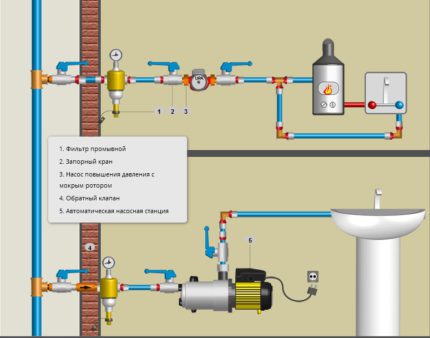
But if water does not reach the upper floors at all, you will have to install high-power pumping station with a hydraulic tank. Such a device is simply installed as part of the plumbing system in a suitable place. The impeller spins, giving the stream of water extra acceleration.
As a result, the pipes fill up faster with water, providing the required pressure level in the water supply. These are compact low-power devices designed to solve local problems.Suction pumps feature higher performance and more sophisticated design.
In addition to a suction pump capable of pumping water to a considerable height, the system is also equipped accumulatorequipped with a special membrane.
The operation of this technique is automated, it is used pressure switch. Water is first supplied to the storage tank, and then fed to the water supply, providing the necessary characteristics inside the system.
Thus, if a centrifugal pump allows you to eliminate the problem in a particular area, then the suction equipment is used to regulate the entire water supply in the house or apartment.
Self-priming boost pumps are capable of lifting liquids to a height of 12 m, while their power starts from 2 m3/ h
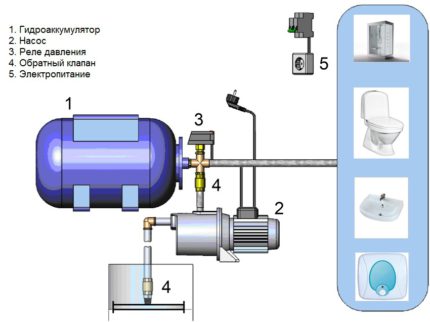
Boost water pressure the pump operates as follows. When the water flow reaches 1.5 cubic meters, the lobe of the motion sensor changes position.
This causes the pump to turn on automatically. When the flow of water stops, the pump turns off. This type of equipment is used both in private cottages and in apartment buildings.
It is especially relevant in high-rise residential buildings, where it is impossible to provide normal water delivery to the upper floors without a special pump. Installing one pump or even a special station with increased power can be a real salvation for residents of the upper floors.
Sometimes you have to use not one booster pump, but two or more. Such a need is sometimes faced by owners of houses in which the water supply system was originally designed with errors.
In this case, you will have to calculate the cost of altering the water supply system (if such an opportunity exists at all) and the costs of installing additional equipment.
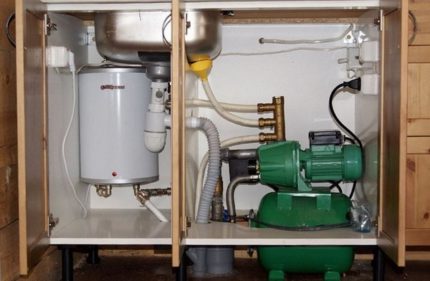
It should be remembered that special types of equipment are intended for pumping hot water. They are made of special heat-resistant materials, therefore they are more expensive than simpler models, designed for contact only with cold water.There are universal booster pumps that are suitable for both cold and hot water.
Conventional power circulation pump small, it consumes less energy than some incandescent bulbs.
When it is included in the system, it is possible to achieve an increase in pressure by about 2-3 atmospheres. If a more serious correction of characteristics is required, preference should be given to more powerful equipment.
Circulation pumps have the ability to work “to a standstill”, i.e. they do not need to be turned off even if all the taps are closed and water is not drawn from the system. The supply pumps operate in approximately the same way to increase the water pressure. These devices are similar in design to circulation models.
If such a pump is turned off, water will circulate freely through its housing. As soon as the engine receives power, the pump turns on. The impeller starts to rotate and the water pressure in the system increases. If a choice arises between systems with automatic or manual control, usually preference is given first.

It is more convenient to use such equipment, and it serves longer, because it does not work idle. It makes sense to take the pump on manual control only in those cases when it will be used either very briefly (temporary option) or extremely rarely (in the summer, at the cottage, only on weekends).
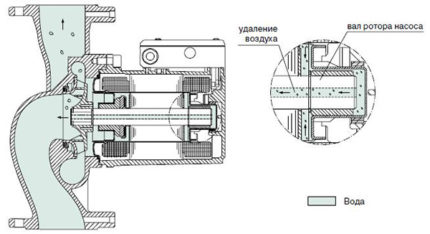
The concept of dry and wet rotor refers to information about the cooling system of the device. In the first case, it is cooled by a stream of air, and in the second by a stream of pumped water.
A wet-rotor pump is cheaper, but it serves less due to the negative effects of sludge accumulating during pumping of water on the working parts. Models with a dry rotor cope with their tasks more efficiently, and they have a longer life.
Rules for selecting unit power
The power of the device should be commensurate with the needs of the system. The lack of pressure is bad, but too much pressure is not needed.
If a too efficient pump is selected for the water supply, the pressure in the system will increase, and all its elements will be subjected to unnecessary additional load. This leads to quick wear and frequent breakdowns.
Stable system water pressure there must be at least two atmospheres. This is enough for comfortable water procedures, as well as for starting an automatic washing machine.
Although some models are more demanding in relation to operating conditions. For example, if the house has a shower, hydromassage, jacuzzi or other similar devices, the pressure should be higher.
In this case, it is better to increase the pressure in the water system to 5-6 atmospheres. Certain types of equipment require even higher performance.
Therefore, the first step before installing a pressure boosting pump should be to study the documentation of household appliances. If some devices are planned to be purchased in the future, their characteristics also need to be taken into account.
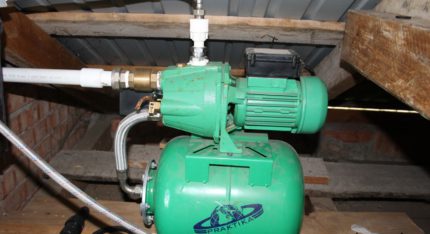
Exact calculations can be done by a specialist, but usually preliminary data made by eye is enough. To determine which pressure really exists in the system, you can use a regular liter can. The water is opened and measured, how many liters of water poured out of the tap in a minute.
Then you need to deal with current needs. If the inconvenience is due to the fact that when the faucet is open in the kitchen, it is difficult to take a shower because of the low pressure, it is enough to use a regular pump, which will increase the pressure for a couple of atmospheres.
But if the house has an automatic washing machine, shower or other equipment of this kind, you should study the technical documentation.
Each such consumer requires a certain pressure of water. Lack of sufficient pressure can lead to the operation of expensive equipment idle.
Household appliances, especially foreign ones, are not designed for such working conditions. Damage caused by the lack of normal pressure can be considered as a case that does not meet the warranty conditions.
You can focus on the maximum pressure plumbing systemindicated in the device passports. If you have a large number of such equipment, you should consult an engineer.
When choosing a suitable water pump model for increasing pressure, one should also consider the needs of the equipment, the acquisition of which is planned in the future.
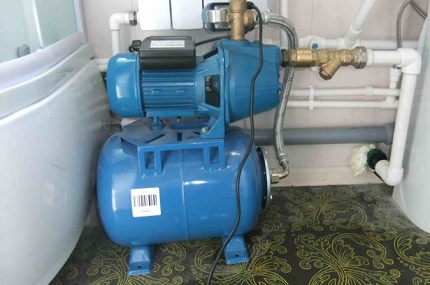
Principles for installing self-priming models
Installing a pump of this type is not very complicated. To do this, you will need about the same skills and tools that are needed to install pumping equipment of a different type.
Schematically, the installation of a booster pump can be represented in the form of the following steps:
- Choosing a place for the accumulator and pump.
- Accumulator installation.
- Installation of pipes for connecting equipment to the water supply.
- Hanging the pump to the wall.
- Harnessing pump and accumulator.
- Checking the operation of the equipment in automatic mode.
In fact, a pump and a hydraulic accumulator with a pressure switch are a variation pumping station. To implement the installation of such a system of devices, you first need to find a place to place the tank.
Some craftsmen replace the hydraulic accumulator with a membrane with a conventional large capacity, for example, a 200 liter plastic tank.
Instead of a pressure switch, the tank is equipped float sensorto ensure that it is automatically filled as needed. Such a tank is installed as high as possible: in the attic or on the top floor. Immediately you should think not only about the dimensions, but also about the configuration of the tank.
A flat and narrow tank takes up less space than a traditional cylindrical model. Although there are no special requirements for capacity configuration. When choosing a location for a tank, you should provide access to the tank / accumulator or the possibility of easy dismantling of this element. This is necessary to perform maintenance, repair or replacement of the device.
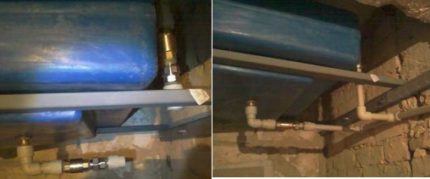
Hydraulic accumulators are delivered ready for installation, but the tank should be prepared. Holes are made in it for the intake and intake of water.You can also make a separate shut-off valve to drain the water in an emergency. Pipes for supplying water to the tank and taking it into the water supply system are mounted to one water pipe.
In modern conditions, it is more logical to use easy-to-install and reliable plastic pipes for the installation of water pipes.
So that air from the pump is not sucked into the tank, and also to prevent water from entering there when the equipment is turned off, check valves should be installed on both pipes. After that, pipes are mounted with which the tank is connected to the water supply system.
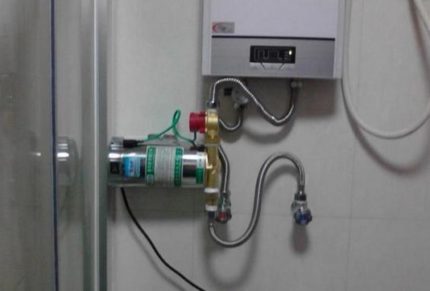
After the tank or accumulator installed and laid the necessary water pipes, you can begin installing the suction pump. Typically, such a device is delivered disassembled. It is first collected, and then proceed to installation.
If you decide to mount the pump on the wall, you must first make a marking for fasteners. Then the pump is suspended and connected to the water pipes. In general, this is not a very complicated operation. An important point is the direction of the fluid in the pump. It is indicated on the case with special marks.
The pump should be installed so that the movement of water is from the tank to the points of analysis of water. Thus, the installation and connection diagram of the pressure boosting pump is as follows: accumulator-pump-consumer. Then the pump is strapped.
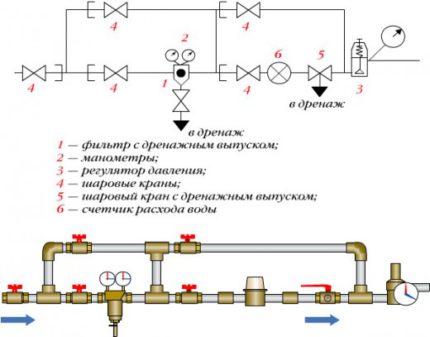
All connections must be carefully sealed. If threaded connections are used to connect the booster pump, a suitable sealant should be used: FUM tape, linen thread, etc.
The amount of sealant should be sufficient, but not excessive. The device is connected to plastic pipes by means of special fittings.
After that, you should check the operation of the entire system. If a tank with a float sensor was used, it is filled with water. Check not only the operation of the sensor. The tank that serves as the storage tank should be checked for leaks. If everything is in order, you can proceed to testing the operation of the pump itself.
The pump must be connected to the mains. It is recommended that the pump switch lever be turned to the automatic mode position. It remains to open the nearest water tap and observe the operation of the device. If the installation is carried out correctly, the pump should automatically turn on and the water pressure will increase markedly.
In this way, the installation of pressure boosting circulation pumps is carried out. For them, choose a suitable place in the water supply, and cut it there. In this case, it is also extremely important to correctly connect the pump, taking into account the direction of fluid flow. If the position of the device is incorrect, the pump will still allow a flow of water.
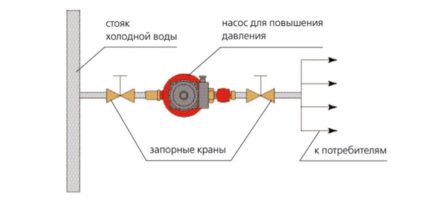
But his work will be extremely inefficient, since the device simply will not function. In the instructions and on the housing, the correct position of the pump is indicated in detail.
After installation, the pump is turned on and checked for proper operation. If the water pressure at the nearest point of water intake has increased, then the installation has been completed correctly.
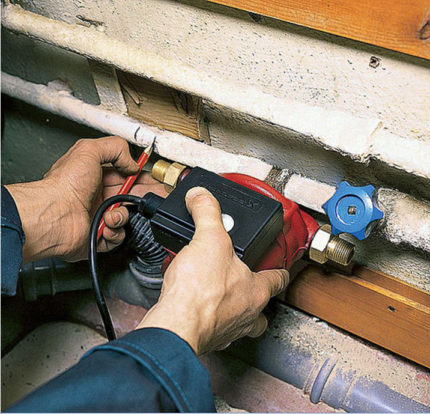
Installing a system with a hydraulic accumulator looks a bit more complicated. First you need to deal with the device of the entire structure.
The pump is connected to the accumulator using special hoses.Then connect the pressure switch, with which the equipment will turn on and off.
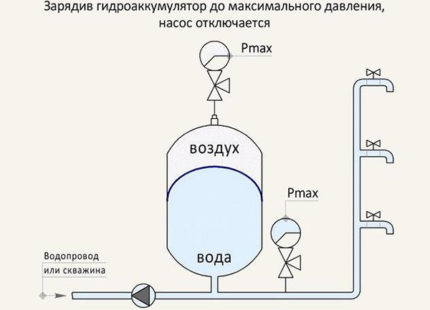
Deserves special attention relay setting. Before starting work, it is recommended that you carefully study the manufacturer's instructions and recommendations.
If there is not enough knowledge and skills for high-quality installation and configuration of equipment, it is better to contact a specialist for advice or fully entrust him with the performance of all work.
Some useful tips
Not always to solve the problem with a low water pressure in the system, a booster pump is indispensable. To begin with, it does not hurt to diagnose the condition of water pipes. Cleaning them or completely replacing them can restore normal pressure without additional equipment.
To understand that the problem is the poor condition of the water pipes, sometimes it’s enough to ask the neighbors living in apartments on the same floor or higher. If they have normal pressure, you almost certainly need to clean the pipes.
If everyone has the same picture, there may be more serious problems regarding the entire water supply system of the house and even the district. In high-rise buildings, water sometimes simply does not flow to the upper floors. It requires high-power and quite expensive equipment.
It makes sense to cooperate with other residents to share costs. A good idea is to demand a solution to the problem from the organization that receives payment for water supply, since it is it that must ensure the supply of water to the consumer.
Lack of water on the upper floors is a violation of fire safety requirements. When communicating with a water service provider, you should pay attention to this point and mention the possibility of a lawsuit in view of non-compliance with legal regulations.
It is best to entrust the installation of equipment in an apartment building to a full-time plumber of the management company. He is better acquainted with the system and will be liable in the event of leaks or breakdowns caused by poor-quality installation of equipment.
Conclusions and useful video on the topic
The operation of the boost pump in the conditions of an apartment of a multi-storey building is presented in the following video:
Cognitive video on installing a boost pump:
Many models of boost pumps can easily be installed independently. Even a novice plumber will cope with this task without any problems. But the level of comfort with a normal pressure of water in the system will increase very noticeably.
Interested in information or have any questions? Please leave comments on the article, post thematic photos. Perhaps you have useful information in the arsenal that you are ready to share with visitors to the site.

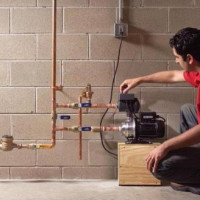 Stations for increasing water pressure: rating of popular models + tips for customers
Stations for increasing water pressure: rating of popular models + tips for customers 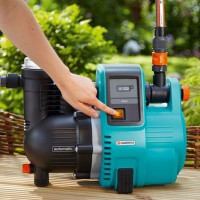 Self-priming pumps for water: types, principle of operation, recommendations for use
Self-priming pumps for water: types, principle of operation, recommendations for use 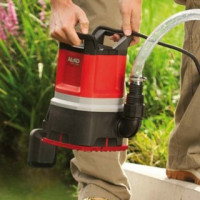 Drainage pumps for water: types, device, operation features
Drainage pumps for water: types, device, operation features 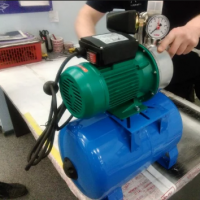 DIY pump station: wiring diagrams and installation rules
DIY pump station: wiring diagrams and installation rules 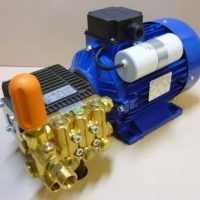 High pressure water pump: operating principle, types, rules for selection and operation
High pressure water pump: operating principle, types, rules for selection and operation 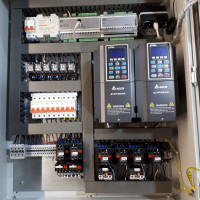 Pump control cabinet: types, connection diagrams, overview of popular models
Pump control cabinet: types, connection diagrams, overview of popular models  How much does it cost to connect gas to a private house: the price of organizing gas supply
How much does it cost to connect gas to a private house: the price of organizing gas supply  The best washing machines with dryer: model rating and customer tips
The best washing machines with dryer: model rating and customer tips  What is the color temperature of light and the nuances of choosing the temperature of the lamps to suit your needs
What is the color temperature of light and the nuances of choosing the temperature of the lamps to suit your needs  Replacement of a geyser in an apartment: replacement paperwork + basic norms and requirements
Replacement of a geyser in an apartment: replacement paperwork + basic norms and requirements
I live in a five-story building on the fifth floor, I also came across the fact that not just there is not enough water pressure in the water supply, but it simply does not reach my floor. No one could tell from whom he did not find out how to solve this problem. As a result, he found all the information and got confused with the installation of a centrifugal self-priming pump. Although I had to sweat well, it solved the problem.
Hello.In your place there was no need to spend money at all, it was better to ask the Criminal Code for non-compliance with the water column pressure standards.
We live in a village on a hill. Water supplied from the center flowed terribly weakly from a faucet. Plus, in winter, because it was not enough in the pipes, it was very cold at home. On the instruction of a comrade, he put a circulation pump for heating and a pump station for needs. For washing and for a geyser, this was enough, however, it is not possible to use everything at the same time.
The apartment is on the 16th floor. If you put only a hydraulic accumulator without a pump, will there be any sense?
In general, there will be no water.
A hydraulic accumulator is a plastic tank for collecting water. Without a pump, it will work like this: you open the water, the tank is filled. When turning the tap to open, water will come from the tank or from the tap, depending on what it is connected to. In the first case, the water will quickly end (well, what capacity the tank can be put in the apartment) and it will be cold. In the second case, there will be no effect at all from the accumulator.
But! If you need a hydraulic accumulator to quickly fill a washing or dishwasher, then such a design solution is justified. The fact is that with a bad pressure of water in the pipes, the washer or dishwasher is typed for a long time, while there is severe wear on the intake elements. When connected to a hydraulic accumulator, the device will take water from it and fill up quickly, as at normal pressure.
Respect to the author, THANKS AND SO HOLD.
Good afternoon, we live in an apartment building on the 4th floor. They installed a pump for raising water pressure and a tank for collecting water on our balcony. The whole problem is that the horses turn off the light in the house, the water supply is turned off altogether. Tell me, is this incorrect pump operation or something needs to be switched?
Hello. I have several options, but it would be nice to know what kind of “tank for collecting water” you have. In general, first of all, it is necessary to check the pressure, presence and operation of the non-return valve, if the accumulator is the integrity of the membrane.
There is definitely a problem in the storage tank, for some reason, it does not collect water. There is another possible reason. For example, after a power outage, you used, for example, flushing water into the toilet and the water from the tank went to the set of tank, electric boiler (if used), and so on.
My task is also to increase the pressure in the water supply. In the country. But it is associated with the installation of a mixer with a heater. There is not enough pressure to turn on the heater. Which pump is better to choose? Water comes from 100 liters. tank. It is located behind the wall above the level of the mixer at 1 m approximately. But the input through the wall is made below.
Since you already have a storage tank, and a large enough volume, you need to choose an automatic pump that will increase the pressure in the water supply system to the necessary.
As the optimal equipment in terms of price / quality ratio, I can recommend the Wilo-PB 088 water pressure pump, which automatically turns on and off depending on the current water consumption. If it is expensive, I can advise a less expensive analogue - the Adriatika JET100L 1.1 kW centrifugal pump. The first order price is $ 100, and the second is $ 60. Wilo-PB 088 is a production of North Korea, Adriatika JET100L - Poland.
The instructions indicate that the pump must be installed either horizontally or with a water supply from bottom to top. Is it possible to install it vertically, with a water supply from above?
Hello.I do not think that the pump will work correctly if you violate the instructions, where the manufacturer gives instructions regarding the correct installation. In your case, it will be more profitable to buy several adapters, the necessary fittings and remake the wiring so that the water supply to the pump is in accordance with the instructions. Believe me, this is not difficult to do, spend only an hour of time, but in the future there will be no problems during the operation of the pump.
If you do not want to change anything in the current wiring, then change the pump to a model where water is required from above.
Nikolay, good afternoon. I live on the 1st floor of a 16-storey building. Under the bedroom in the basement installed a water pressure pump. At night, a low-frequency sound is heard that just exhausts. The question is: is it possible to move the pump 6-8 meters from the designated place to an adjacent room, which is located under an undesirable zone, by extending the pipe?
Hello, Inna. You are heroically patient. You live in MKD. You have a UK.
SP 51.13.330 2011 tab. 1, after paragraph 6.3 - is included in the list of mandatory standards. See tab. 1, there are indicated the maximum permissible values of noise in different categories of buildings. Write a statement to the Criminal Code so that they replace, soundproof or do something else so that the pump does not exceed permissible norms. You yourself have no right to change anything. If they don’t want to - Rospotrebnadzor and the Housing Inspectorate did not seem to be abolished.
As I understand it, is this a common pump or your personal one?
“The power of a conventional circulation pump is small, it consumes less energy than some incandescent lamps. When it is included in the system, it is possible to achieve an increase in pressure by about 2-3 atmospheres.”
Not a single “ordinary” circulation pump will raise the pressure to 2-3 atmospheres, even at zero flow. 1 atmosphere is the maximum, but also in the absence of water extraction.
Hello. I live on the 4th floor of a 5-storey building. Water supply is carried out constantly in an abridged manner so that it pumps out extremely rarely even at night. The pressure is often not enough, even to start the washing machine.
Please tell me which pump option will help in this situation. And also recommend, please, the optimal place for its installation (in the apartment, or in the basement).
Hello Andrey. First of all, you need to clarify that in your case you will need two pumps: one to increase the pressure in the system, and the second - circulating. I also advise you to purchase a storage tank for water with a capacity of at least 100 liters. The most budget option is a plastic barrel.
As for pumps, from personal experience I can recommend Oasis, where a duct sensor is preinstalled. That is, you do not need to turn the pump on and off constantly, it will work automatically. The consumption of such equipment is only 120 W.
You need to install pumps and a tank directly in the apartment if you plan to increase the pressure of water only for yourself.